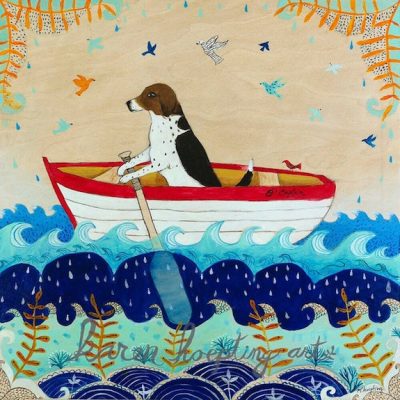
When twenty-two year old Charles Darwin set off on a five-year trip to South America and beyond, it was as a naturalist. The main purpose of the trip was to survey the coastline of South America and chart its harbors to make better maps of the region, and anything Darwin did was just an added bonus. The “bonus” turned out to be observations that helped him develop the theory of evolution.
The ship that took him on his journey was Her Majesty’s Ship Beagle, or HMS Beagle, and it is the topic of our post for reasons that are obvious for a dog-centric site.
HMS Beagle was a Cherokee-class 10-gun brig-sloop of the Royal Navy, one of more than 100 ships of this class, and yes, it was named after the dog breed. It may seem strange to us today to name a ship after a dog, but naming ships after animals was common practice for the British Royal Navy, particularly for survey ships: Barracouta, Rattlesnake, Scorpion, Mastiff, Starling, Raven, and even Squirrel were all names for British Royal Navy survey vessels. In fact, the Beagle that Darwin sailed on wasn’t the first ship to have that name.
Back then (and perhaps even now), the British Royal Navy assigned names to ships on a circulating basis. When one ship was retired or lost at sea, the name of that ship was put back on the available “names list” for new ships being built. The H.M.S. Beagle on which Darwin sailed was the third ship to have that name, and the name was probably the next one available on the list when the ship was completed. In fact, at least eight vessels of the Royal Navy have been named HMS Beagle.
As an aside, when a lander was launched into space as part of a program to explore Mars in 2003, it was named Beagle 2. Professor Colin Pillinger, the planetary scientist behind the Beagle 2 project, said, “HMS Beagle was the ship that took Darwin on his voyage around the world in the 1830s and led to our knowledge about life on Earth making a real quantum leap. We hope Beagle 2 will do the same thing for life on Mars.” Unfortunately, Beagle 2’s probe didn’t deploy correctly. A Beagle 3 project was proposed, but rejected by ESA in 2004.
But we’ve digressed.

HMS Beagle off the galapagos by john chancellor by Karen E James licensed under CC BY-NC-SA 2.0
Some ten years after Darwin’s completed journey, HMS Beagle was transferred to the coast guard in 1845 and moored on the River Roach in Essex. In 1870, the vessel was likely dismantled at a submerged mud berth on the same river, but the Royal Navy continued to use the name for another six ships.
But guess what?
In 2003, a team from the University of St. Andrews (with the support of the aforementioned Professor Pillinger) conducted a remote sensing survey of the marshland alongside the River Roach. The results suggested that deep within the mud was evidence of the remains of the lower part of a ship’s hull. It seems that the buyers who bought the Beagle dismantled it beside the river bank and used parts of it to build nearby buildings, but they left the lower hull in the mud thinking that the river would claim it as its own. In 2008, an archaeological survey concluded that much of HMS Beagle’s remains were actually still buried in the mud. In 2019, Historic England commissioned Wessex Archaeology to investigate the mudflats ahead of the ship’s bicentenary of the launch in May, 2020, and they confirmed the location of the mud dock. You can see photos and read more about this effort here.
The remains of the dock have now been recognized as a site of national importance, and from our point of view, it just goes to show you that you can’t keep a Beagle down.
Image: Beagle by Karen Hoepting, owner of PetiteWing, is available for purchase here
